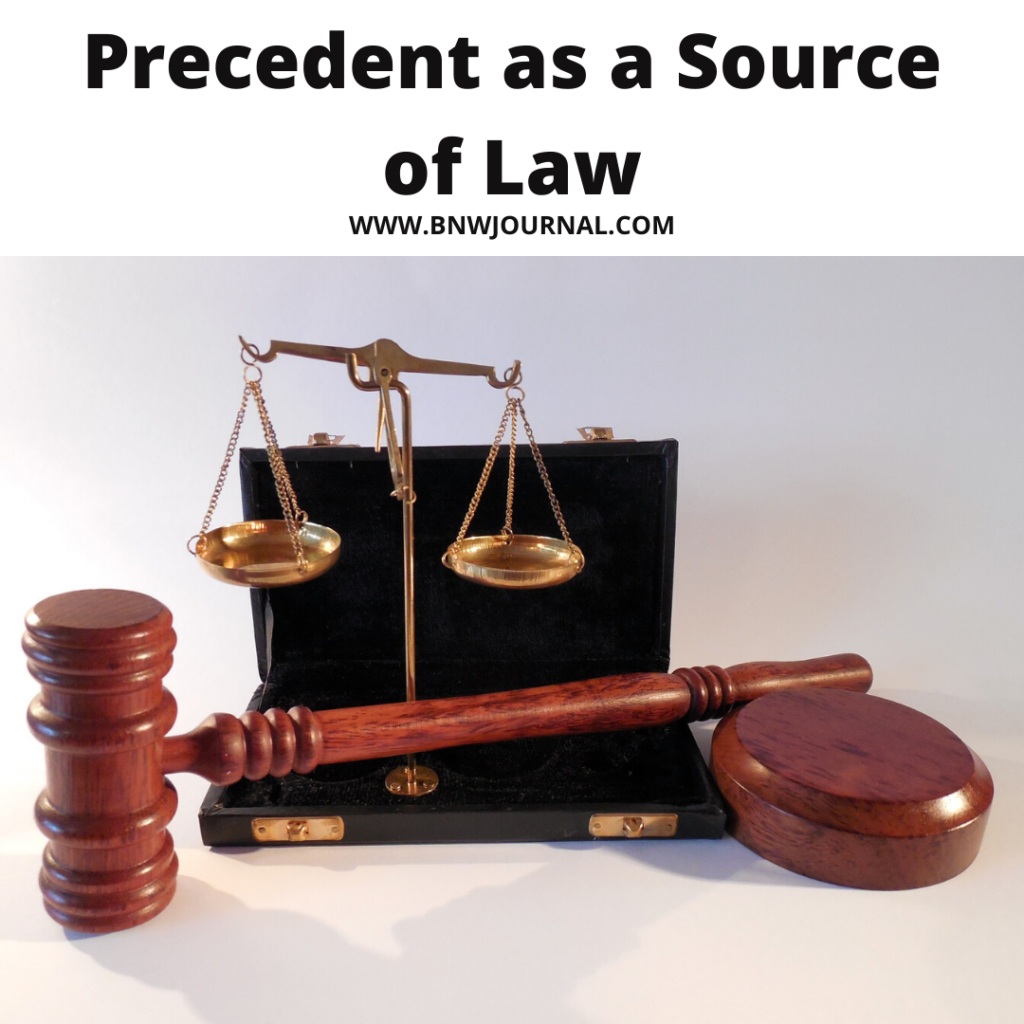![]()
Introduction:
The doctrine of precedent is a general rule of common law, which works by requiring judges to follow the decision made in the previous cases, thus ensuring that there is consistency in the law. Thus the people coming to the court of law will be able to make an educated guess as to the potential success and the likely outcome of the case in question.

The adherence to precedent binds the subordinate courts to follow the stare decisis of previous cases by higher courts. On several occasions in the past, the courts, in a reappraisal of its attitude to the stare decisis rule has recognized significant exceptions to it. There are so many justifications given for its overruling. This assignment examines the concept of precedent and justifications for its overruling especially in the context of Benjamin N. Cardozo’s view on this issue.
HISTORICAL BACKGROUND OF PRECEDENT
Stare decisis is the rule of English common law that requires judges to “stand by” their previous “decisions”. While phrased in Latin, stare decisis “was not enunciated” as a principle in English law until the nineteenth century.[1] However, the gestation of stare decisis begin in the thirteenth century. Before this period and for long after, its development was limited by royal fiat: If you could appeal to legal principle what you would say would be well enough, but against the king, who is above the law, you can rely on legal principle. Even with the gradual removal of this limitation, the application of stare decisis as a legal principle was not possible without a reliable and objective system for reporting judicial opinions.[2] This did not occur in English law until the advent of Year Books in the late 1200’s.[3]
Before the advent of Years Books, legal principles established by case law usually took the form of an appeal to the memory of judges and barristers. While some cases reported in these earlier periods were memorized, the reliability and objectivity of the reports were highly suspected.[4] From this perspective, the Year Books represented the “crude beginnings of law reporting.”[5] The decisions of English judges reported in Year Books were initially regarded as “only evidence” of the law instead of binding precedent.[6] Toward the end of the sixteenth century, given an ever-increasing body of case law within which to root, this limitation also began to erode.[7] The system of binding precedent that is the hallmark of the modern English and American judicial systems came to full flower during the late eighteenth century and early nineteenth century.[8]
The locus classicus of the rule which holds that the House of Lords in its judicial capacity is bound by its own prior decisions is to be found in the famous case of London Tramways Co. v London County Council, 1898 AC 374[9].
DOCTRINE OF PRECEDENT
Cardozo in his work, “The Nature of Judicial Process” write about the need of precedent that, “when the law has left the situation uncovered by any pre-existing rule, there is nothing to do except to have some impartial arbiter declare what fair and reasonable men, mindful of the habits of life of the community, and the standards of justice and fair dealing prevalent among them, ought in such circumstances to do, with no rules except those of custom and conscience to regulate their conduct.”[10]
Stare decisis is the policy of the courts to stand by precedent. The expression stare decisis is but an abbreviation of stare decisiset non-quieta movere (to stand by or adhere to decisions and disturb that which is settled). Thus stare decisis means “what the court did, not what it said.”[11] The doctrine is central to legal reasoning, briefs, arguments, decision-making, and opinion writing. Yet precedent is but one aspect of the doctrine of stare decisis. Precedent means simply that like cases get alike treatment. stare decisis requires that the holding of a similar case with sufficiently similar facts to the case at issue, applies to courts of equal or lesser hierarchy within the same jurisdiction.[12]
Bindingness depends on the hierarchy of courts; higher courts bind lower courts, never vice versa. Law quality relates to the principle behind a decision, its ratio decidendi, as Jessel MR states: “the only thing in a judge’s decision binding as an authority upon a subsequent Judge is the principle upon which the case was decided.”[13] stare decisis representing the apotheosis of a legalistic ideology believes that law should be founded upon such values as certainty, consistency, and continuity.[14]
The decision of a court of another jurisdiction only acts as persuasive authority. The degree of persuasiveness is dependent upon various factors, including, first, the nature of other jurisdictions. Second, the degree of persuasiveness is dependent upon the level of court which decided the precedent case in the other jurisdiction.
Not everything a judge says when giving judgment constitutes a precedent. Why not everything a judge says in the course of his judgment constitutes a precedent is that, among the propositions of law he enunciates, only those which he appears to consider necessary for his decision form part of the ratio decidendi; and thus to amount to more than an obiter dictum. If, in a later case, precedent binds the judge, then according to the English doctrine of stare decisis, he must apply the earlier ratio decidendi however much he disapproves of it. Unless, to use the words of Lord Reid, he considers that the two cases are ‘reasonably distinguishable’.[15]
Dicta in earlier cases, of course, frequently follows or applies, but dicta are never of more than persuasive authority. No judge is in binding to follow them. Even when the ratio decidendi of a previous case is merely a persuasive authority, it is necessary to follow in later cases; unless the judge has good reason to disapprove of it. It constitutes a precedent, and the difference between a persuasive precedent and an obiter dictum is only slightly less significant than that between binding and persuasive precedents.
If, for example, a High Court judge of the first instance concludes that the containment of a proposition of law in a previous opinion of another High Court judge of the first instance is the ratio; then there is a great deal more reluctance to differ from it than in the case, if he has satisfaction that it is merely a dictum; although a judge of the first instance is not in binding to follow the decision of another judge of the first instance.[16]
Obiter dictum means something said in passing. A judicial comment passes during delivering a judicial opinion, but one that is unnecessary to the decision in the case and is therefore not in precedent though it may be considered persuasive.[17]
Distinction Between Ratio Decidendi and Obiter Dictum
The distinction between ratio decidendi and obiter dictum is an old one. As long ago as 1673 Vaughan C.J. said:
“An opinion given in court, if not necessary to the judgment given of record, but that it might have been as well given if no such, or a contrary had been broached, is not judicial opinion; but a mere gratis dictum.”[18]
There are undoubtedly good grounds for the attachment of importance to the distinction between ratio decidendi and obiter dictum. In this context an obiter dictum means a statement by the way, and the probabilities are that such a statement has received less serious consideration than that which is devoted to a proposition of law put forward as a reason for the decision. It is not even every proposition of this nature that forms part of the ratio decidendi.[19]
Bibliography
I. Books
- Cross, Rupert & Harris J.W.: Precedent in English Law,(Clarendon Press, Oxford, 4th edn., 1991).
- Ram, James: The Science of Legal Judgment, 47 (Fred B. Ratham & Co.1988).
- Lakshminath, A.: Precedent in Indian Law,(Eastern Book Company, Lucknow, 2nd edn., 2005).
II. Articles
- White, James B.: “What’s An Opinion For?” 62 U. Chi. L. Rev.1363 (1995).
- Lewis, Ellis T.: “The History Of Judicial Precedent” XLVI Law Q. Review 216 (1930).
References:
[1] Rupert Cross & J.W. Harris, Precedent in English Law 25 (Clarendon Press, Oxford, 4th edn., 1991).
[2] James B. White, “What’s An Opinion For?” 62 U. Chi. L. Rev.1363,1366 (1995).
[3] T. Ellis Lewis, “ The History Of Judicial Precedent” XLVI Law Q. Review 216(1930).
[4]Supra note 3 at 216.
[5]Id. at 216.
[6] James Ram, The Science Of Legal Judgment 47 (Fred B. Rothman & Co.,1988).
[7]Supra 3 at 344.
[8] Sir William Holdsworth, “History of English Law” 157 (A.L. Goodhart & H.G. Hanbury (eds.), Methuen & Co.Ltd. 1956).
[9] A. Lakshminath, Precedent in Indian Law VI (Eastern Book Company, Lucknow, 2nd edn., 2005).
[10] See Pg. 142.
[11] R.J. Aldisert, “Precedent: What It Is and What It Isn’t; When Do We Kiss It and When Do We Kill It”,17 Pepperdine Law Review 605(1990).
[12] Black’s Law Dictionary, 1261 (5th edn., 1979).
[13]Osborne v Rowlett (1880) 13 ChD 774 at 785.
[14]Supra note 9 at 13.
[15]Ushers Wiltshire Brewery Ltd. V Bruce (1915 A.C. 433).
[16] Rupert Cross, Precedent In English Law, 34-35 (Clarendon Press, Oxford, 1st edn., 1961).
[17] Black’s Law Dictionary, 1100 (7th ed., 1999).
[18]See details supra note 14 at 35.
[19]Id. at 36.



0 Comments